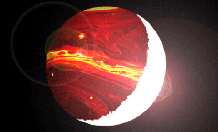
An artist's impression of a 'hot Jupiter'.
Exeter team to adapt weather forecasting for Exoplanets
A University of Exeter team is adapting the UK Met Office’s weather and climate model to study the atmospheric properties of planets orbiting other stars.
The team, led by Professor Isabelle Baraffe of the University of Exeter, comprises astrophysicists, climate scientists and meteorologists.
Two teams of scientists from the University of Exeter and the Met Office will present their work at the National Astronomy Meeting in Manchester on Friday 30 March.
Dr David Acreman of the University of Exeter’s Astrophysics Group will present the project at the National Astronomy Meeting. He said: “The Met Office has developed a sophisticated tool for Earth weather forecasting and climate studies. It could be of vital importance in the interpretation of the wealth of observational data on extra-solar planets we expect to come within the next decade.”
“Most of the hundreds of extra-solar planets discovered to date are gas giants orbiting very close to their host star. These planets are strongly irradiated by the parent star, with one side experiencing permanent day and the other in permanent night. The day side of the planet is much hotter than the night side and this temperature difference causes high speed winds to flow. These winds can be as fast as a few kilometers per second. Although these conditions are unlike anything seen on Earth, the Unified Model is capable of handling these extreme circumstances.”
The project aims to help understand the redistribution of heat from the dayside to the nightside, determine the key parameters affecting the efficiency of such heat redistribution and study the deep circulation patterns driven by the winds and their effects on the planet’s internal structure. In the longer term, the project will be extended to the study of Earth-like exoplanet atmospheres, where conditions may resemble those found in the early or present day Solar System, and to the determination of biosignatures, potentially revealing the presence of a biosphere and life.
Future observational projects will shed new light on extra-solar planets, but interpreting the data will require an increased understanding of the planets being observed.
“By adapting the Met Office model to the conditions found on those planets we can interpret these observations, and use them to understand how the physics governing our weather and climate behaves in an environment very different from our own,” explained Dr Nathan Mayne, also of the University of Exeter’s Astrophysics Group. “The feedback will provide valuable tests of our numerical models under extreme conditions and demonstrate its adaptability and robustness.”
At the event, the Met Office will also announce its plans to expand its services to provide operational space weather forecasts for the UK. It has pooled skills with the UK’s space weather research community to extend its ‘Unified Model’ upwards to include the Earth’s thermosphere, a region about 90-600km above the Earth surface. Conditions in the thermosphere are chiefly determined by solar influences, so the impact of space weather events is very commonly seen in this region.
“Space weather can affect the aviation and power industries, as well as a whole range of activities that rely on GPS timing and positioning, radio communication or satellite-based observations,” said the Met Office’s Dr David Jackson, who will present the project on Friday 30 March.
“To develop an accurate, useful advanced-warning system for space weather, we need to develop a system of interconnected models that describe the whole domain – the conditions on the Sun, interplanetary space, the layers of the Earth’s atmosphere, all the way down to the Earth's surface. The more accurate we can be in representing interactions between the lower atmosphere and thermosphere, the more we can enhance thermospheric forecasts, and thus improved space weather forecast products for users,” Jackson continued.
The University of Exeter has one of the UK’s largest astrophysics groups working in the fields of star formation and exoplanet research. The group focuses on some of the most fundamental problems in modern astronomy – when do stars and planets form and how does it happen? They conduct observations with the world’s leading telescopes and carry out numerical simulations to study young stars, their planet-forming discs, and exoplanets. This research helps to put our Sun and the solar system into context and understand the variety of stars and planetary systems that exist in our Galaxy. Through its science strategy, the University is seeking to invest £230 million of internal and external income in five key themes of activity, one of which is Extrasolar Planets.
Date: 30 March 2012
